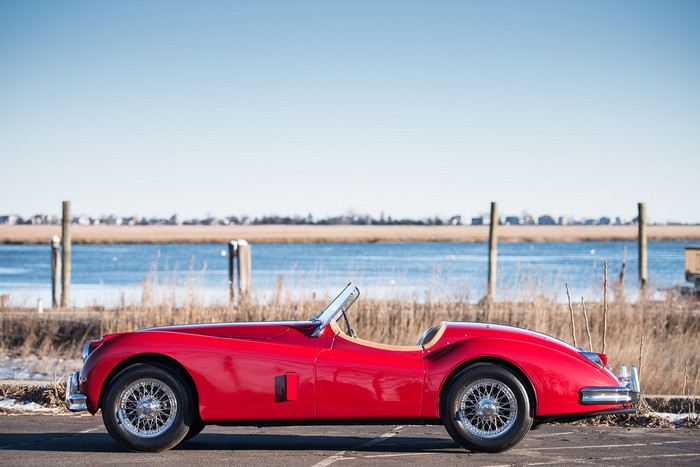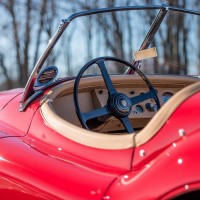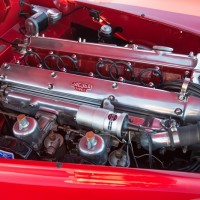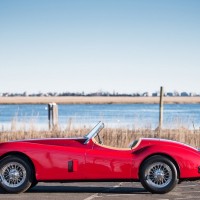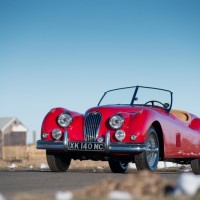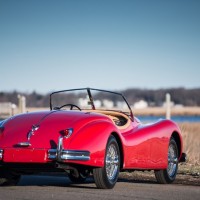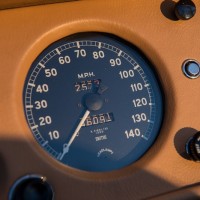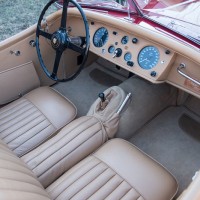From 1948 through 1954, the groundbreaking XK 120 established Jaguar at the forefront of sports car manufacturers with its graceful lines and impressive, race-winning performance. Late in 1954, the improved XK 140 arrived, heralding comprehensive improvements that made the original design even better.
Notable upgrades included precise rack-and-pinion steering, improved brakes and engine cooling, plus enhanced cabin comfort and legroom. Subtle body updates preserved the widely acclaimed original styling elements. The most popular model in America remained the OTS (open two-seater), otherwise known as the Roadster. Of the 3,350 XK 140 Roadsters built, only 49 were sold in England. At the U.S. price of $3,745, the cars continued to deliver Jaguar’s characteristically excellent value.
According to this car’s Jaguar Daimler Heritage Trust Certificate, this striking XK 140 MC Roadster from 1955 is an original left-hand-drive, U.S.-delivery example. It is equipped with the top-of-the-line “MC” package.
The MC option included the “M” or “Special Equipment” package, which included a crankshaft dampener, dual exhaust pipes, enlarged SU H8 carburetors, twin fog lamps and wire-spoke wheels.
The “C” designation stood for the addition of a high-compression, Le Mans-proven C-type cylinder head, raising engine output from the 3,442-cc DOHC inline 6-cylinder engine with twin SU H8 (two-inch) carburetors to a heady 210 horsepower.
The car is equipped with a 4-speed manual gearbox without overdrive and four-wheel hydraulic drum brakes. The independent front wishbone suspension has torsion-bar springs and an anti-sway bar, and the rear suspension consists of a live axle with semi-elliptical leaf springs.
The car underwent a concours-quality restoration in the early- to mid-1980s, and it then was placed in a private collection, where it was sparingly used and carefully stored.
The car remains impressive in every aspect, with a straight body, proper panel alignment, lustrous Carmen Red paint and a handsome cockpit trimmed in Biscuit Connolly hides. A Jaguar specialist recently attended to the car, and work included new front and rear brake cylinders, a new master cylinder, a rebuild of the original radiator, resurfacing of the cylinder head, plus new gaskets, hoses and more.
SCM Analysis
Detailing
| Vehicle: | 1955 Jaguar XK 140 MC Roadster |
| Number Produced: | 3,347 |
| Original List Price: | $3,745 |
| Tune Up Cost: | $650 |
| Chassis Number Location: | Data plate on firewall |
| Engine Number Location: | Right side of block |
| Club Info: | Jaguar Clubs of North America |
| Website: | http://www.jcna.com |
This car, Lot 3, sold for $137,500, including buyer’s premium, at the Gooding & Company Amelia Island auction on March 8, 2013.
Why do we buy classic cars? Because they’re good investments? Because we can use them to impress our friends? Because we want to own a piece of automotive history?
Or are there, possibly, people out there who still buy a classic car in anticipation of driving it fast down an old-timey two-lane road, as safely and comfortably as possible, but still realizing they’re enjoying an experience that a modern car just can’t provide?
For those who opt for one of those first motivations and are thinking about a Jaguar sports car, then the XK 140, even one with the initials after the model designation, is probably not the right car. Instead, they should buy an XK 120, perhaps even one of those first alloy-body models with the spats on the rear fenders.
The opportunity for appreciation is higher, the clean, uncluttered lines and complex grille are more eye-catching, and there’s no argument that this model was the one that defined the market after World War II for affordable — but distinctive — high-performance sports cars. Such a car can then be carefully maintained to be admired in the motor house and carefully trailered to occasional concours shows in competition for additional trophies.
But for those who really want a car that can be driven with enjoyment, then the XK 140 is a better option, and the MC version is the aspirational choice.
Making a successful car even better
Having created the XK 120, with its sleek hand-rolled alloy panels, primarily as a show stand for Jaguar’s new double-overhead-cam XK engine, the Jaguar executives and engineers had to scramble when demand for the show cars displayed at the 1948 London Motor Show exploded beyond Jaguar founder and chief designer William Lyon’s wildest expectations.
The problem with the XK 120, as incredible as it looked and sounded, was that it wasn’t — and isn’t — very satisfying to drive. However, when it was introduced, only the MG TC, Morgan 4-4, and Porsche 356 could be called sports cars in the same breath, and none of them offered more power, a more comfortable cockpit or better handling than the XK 120.
However, with the introduction of the Austin-Healey 100 and the Aston Martin DB2/4, the sports-car world was starting to look a little different. Horsepower and sleek lines alone were no longer sufficient to take the top of the hill in the growing market for true sports cars.
Le Mans-inspired improvements
Fortunately, in the six years from 1948 to 1954, Jaguar paid attention to the comments of prospective buyers who were attracted to the XK 120’s sleek lines and 120-mph capability but were put off by its impractical nature. Engineers back in Coventry were learning from the experience of drivers such as Phil Hill and Stirling Moss in XK 120s and the derivative C-types, who were coming back with recommendations for improvements — as well as trophies — from venues as diverse as Pebble Beach, Alpine rallies, and the 24 Hours of Le Mans.
On the new XK 140 model, the cramped pedal box was expanded and the firewall moved forward to provide needed legroom. The steering was changed to a more responsive rack-and-pinion system, and the steering column repositioned so that there was more space between the driver’s chest and legs and the still-large wheel.
Although it was less elegant, the new flat center steering-wheel boss was a safety improvement over the previous center that had been aimed like a 155-mm howitzer shell right at the driver’s sternum. Suspension travel had been increased, and the stiffer torsion springs were better matched with tube-type shock absorbers that replaced the lever shocks, providing a smoother ride with more tractable handling.
The XK 140’s stylish lines had changed almost not at all from the XK 120 show cars introduced in 1949. The long bonnet and sweeping front fenders —and the short-coupled rear end placing the driver just in front of the rear axle — carried forward from the XK 120. Chrome strips had been added down the middle of the bonnet and continuing down the middle of the boot lid to culminate in a medallion that touts the company’s victories at Le Mans.
The best version of a great cat
With these changes, even in basic trim, the XK 140 is a more well-rounded car for the modern driver than the best of the XK 120s. Although they are heavier and less stylish, the bumpers make the car more practical in everyday use, and the cast grille is both less fragile and better at helping the engine stay cool than the previous metal-fin version.
Still raced successfully in vintage events today, these leaping cats really come into their own on fashionable high-roller rallies, where an attractive co-driver won’t fear four long, hard days in the cockpit. The car will vie for covetous glances at the lunch stops.
The knowledgeable buyer knows that the best version of the XK 140 bears the initials MC (SE on the few RHD English models sold). The M shows that the car came equipped with wire-spoke center-lock wheels and attractive, functional fog lamps. The C showed that the formidable C-type engine head and larger carburetors had been installed on the jewel-like engine, making the car capable of running at the head of the rally pack on back roads in California, Colorado or Arizona.
I can speak from firsthand experience of both the satisfying driving experience and reliable performance of these marvelous icons, having had the chance on a few occasions to drive the all-original lavender-gray XK 140 MC of a good friend of mine.
Until he passed away last year, my octogenarian friend still owned and aggressively drove the XK 140 MC that he purchased new in Seattle with poker money won while he was stationed with the Air Force in the Pacific during the Korean War.
Over the nearly 60 years that he owned the car, my friend was as proud of the speeding tickets he had talked his way out of on late-night runs along the coast as he was of the trophies he won in Jaguar Club concours and the plates from the California Mille that hung in his garage.
A friend who inherited the XK 140 continues to drive and appreciate the car.
I can only hope that whoever bought this car in Florida — paying at the high end of the wildly variable market for these fine cars — will enjoy his or her time behind the wheel of an XK 140 MC as much as my friend did. Well bought — for the sheer driving pleasure. ?
(Introductory description courtesy of Gooding & Company.)
